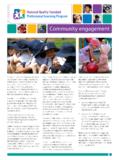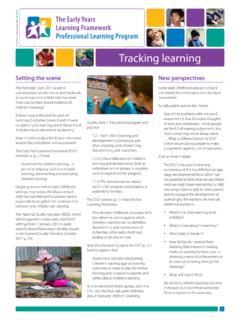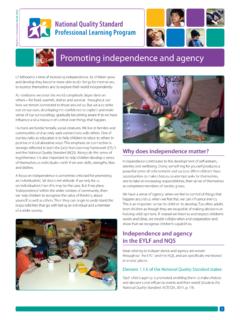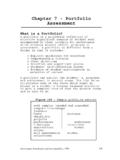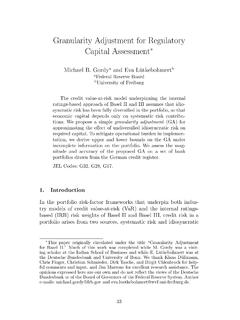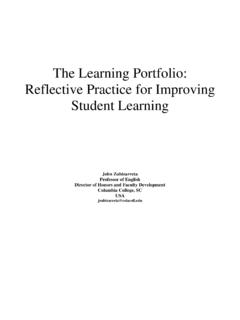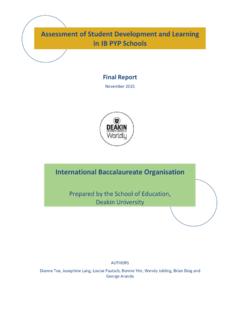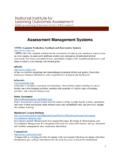Transcription of Taking the analysis of collected information further
1 1 NQS PLP e-Newsletter 2012 The focus of the last e-Newsletter was formative assessment the range of ways educators collect information about and analyse children s learning. This e-Newsletter explores how educators analyse that collection of information to make a summative assessment of each child s helps us to: celebrate strengths, interests, learning and development acknowledge cultural backgrounds notice if there are gaps in our knowledge notice if there are social and/or learning difficulties that require further support discuss progress with families and children plan to further support each child s learning and development meet the requirements of the National Regulations and the National Quality Standard (NQS).
2 What are the requirements for assessment in the National Regulations and the National Quality Standard?Details about requirements can be found in the National Law: Section 168 and the National Regulations: Regulations 73 76. Helpful advice can also be found in the Guide to the Education and Care Services National Law and National Regulations (Guide 2 in the National Quality Framework Resource Kit, ACECQA, 2011a):The approved national learning frameworks outline that assessment is a process used by educators to gather information about what children know, understand and can do. This information should be analysed by educators to plan effectively for each child s information can also be used by educators to reflect on their own values, beliefs and teaching practices, and to communicate about children s learning with children and their children who are preschool age and under, this documentation should include: assessments of the child s development needs, interests, experiences and participation in the educational program assessments of the child s progress against the learning outcomes of the educational program (p.)
3 53).A copy of assessments or evaluations of their child also needs to be available for families and given to them when requested (p. 54). Summative assessmentTaking the analysis of collected information furtherSummative assessment What does it mean?The term summative describes assessment processes that sum up what a child has learned by reviewing documentation gathered over time from a range of sources. These processes bring together information about what the child knows, understands and can do in relation to the Early Years Learning Framework (EYLF) Learning Outcomes. Summative assessment differs from analyses of learning that occur for individual pieces of documentation such as anecdotal records, photos or learning stories, as it involves reviewing a range of records in order to understand and document the distance travelled by a Educators Guide to the EYLF (DEEWR, 2010) refers to assessment as.
4 An ongoing process of using observations or evidence to make judgements about children s learning and educators pedagogy. assessment includes interpreting children s learning against learning outcomes in order to plan for further learning and to report to parents and others about children s learning (p. 37).Principle 5 in the EYLF reminds us that reflective practice is essential. Reflection is particularly important in summative assessment . We question what we know about the child, interpret and analyse the information collected and reflect on what this tells us about their learning and development and how we can support the child further .
5 Involving colleagues, families and, if possible, the child in the process adds different perspectives that lead to a deeper understanding of learning outcomes mentioned above refer to the five Learning Outcomes in the EYLF that provide early childhood educators with key reference points against which children s progress can be identified, documented and communicated to families, other early childhood professionals and educators in schools (EYLF, DEEWR, 2009, p. 17). We know that children s learning is ongoing and that each child will progress towards the outcomes in their own way and at their own pace.
6 Their progress in each outcome will depend in part, of course, on age. For example, a baby who reaches out his hand for more after a finger play of Round and round the garden is responding to and engaging with an educator with whom he feels comfortable (Learning Outcome 1). An older child who tells his educator about the football team he barracks for winning at the weekend, adding lots of detail about who kicked the goals, is also demonstrating learning related to Learning Outcome 1. These examples also link to Learning Outcome 5, which demonstrates that the outcomes are interrelated as well as distinct.
7 It is important to remember that children will demonstrate progress in ways other than those listed under the Guide to the National Quality Standard (ACECQA, 2011b) clarifies the expectations about assessment in Standard , and Element refers specifically to assessment . The Guide states that assessors may discuss how educators analyse the information that is gathered about individuals and groups of children to make judgments about each child s progress towards specific learning outcomes . Assessors may also sight documented assessment and evaluation by educators, which includes what children know, say and can do, and evidence that shows how this assessment /evaluation leads to future curriculum decision making that extends children s learning (p.)
8 41).Turning a collection of information into a summary of the child s learningEducators collect a range of information , some of which is analysed and acted on at the time. Summative assessment ensures that everything that has been collected is analysed in relation to the Learning Outcomes. This occurs when educators regularly and systematically look at photos, jottings, anecdotal observations, learning stories, samples of the child s work, information shared by the family and other information , and ask the question How does this all fit together, how does it link to the Learning Outcomes and what does it tell me about the distance travelled by this child?
9 Through summing up what has been gathered, educators gain greater insight into children s relationships, cultural context, interactions, learning styles, dispositions, understanding of concepts and interests. Educators draw on educational theories and knowledge during the services may choose to produce portfolios or learning journals as a way of documenting assessment and progress towards learning outcomes. If so, these must include an analysis of children s learning to meet the requirements of the National Regulations.(Guide to the National Law and National Regulations, ACECQA, 2011a, p. 54).3 Example A: Whatever method is used, summative assessment should.
10 Emphasise children s strengths and make their learning visible draw on the family s knowledge about their child so that the documentation reflects the child s life at home as well as at the service be free from bias be written in clear, easy-to-understand language that makes sense to families reflect knowledge of the child s social or cultural background occur systematically and regularly so that, over time, educators gain a complete picture of each child s progress in relation to the Learning to support further learningThe summing-up process may identify gaps in information relating to a particular Learning Outcome.



